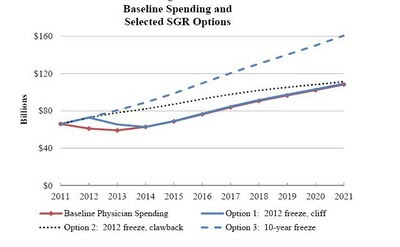Today’s Managing Health Care Costs Indicator is 29.4%
The Congressional Budget Office just released physician fee schedule that would be required in 2012 under current Medicare rules. The SGR short for sustainable growth rate, mandates that if the increase in total physician costs exceeds an index of practice cost inflation, unit prices will be decreased by up to 7% the following year. The SGR has generated steep physician fee schedule cuts each year since 2002, and Congress has stepped in on multiple occasions to “fix” the SGR and be sure that physician fees would be level, or go up slightly.
But Congress hasn’t simply appropriated more money for Medicare to account for reversing these fee schedule decreases. That would have been too transparent!
Instead, Congress has utilized a two accounting maneuvers to maintain a fiction that increased costs in the next year would be recouped at some point in the future. These accounting maneuvers have been used through Democratic and Republican administrations and legislative majorities. They have allowed our representatives to kick the can forward.
The CBO explains these accounting maneuvers in yesterday’s briefing.
Clawback: Congress pretends that costs will be decreased in the ‘out’ years, so that when the CBO is scoring ten year impact, it appears that there is little or no cost to preserving the physician fee schedule.
Cliff: Congress eliminates the floor for payment, and pretends that in subsequent years the SGR could lower fees by more than the initial SGR would have allowed. Again, the CBO would follow this fiction and project little or no cost to the SGR override over a ten year time horizon.
Congress has intermittently also chosen to freeze, rather than decrease physician fees. A freeze keeps fees at current levels, offering no cost of living increase. Freezes mean that overall Medicare costs continue to climb, as physicians deliver more and higher intensity services. A freeze means that no one is happy – Medicare costs go up AND physicians see their office expenses increase without a corresponding increase in their reimbursement.
As I said at the top of the post, a 29.4% decrease in Medicare reimbursement of physicians would be catastrophic. Most nonprocedural physicians have office expense that approaches or exceeds 50% of revenue – so losing a third of revenue could theoretically cut physician income by 2.3. Physician access for senior citizens would be severely diminished, and the viability of many physician practices would be threatened. I don’t think there are any responsible health policy experts who think that’s a good idea.
Click to enlarge. Note "baseline" assumes that SGR is reversed and there is no 29.4% physician fee decrease.
As you can see in the CBO chart, every option leads to higher provider costs over the next 10 years. The “baseline” case assumes that the 29.4% decrease is implemented this January. We’ve had ten years of accounting tricks that obscure the real cost of Medicare. We need to overturn this potentially devastating cut in physician payment. We also need to support fundamental reform, including bundling payments to limit fee-for-service and implementing the Independent Payment Advisory Board, bundling payments to address the underlying causes of increasing Medicare costs.












